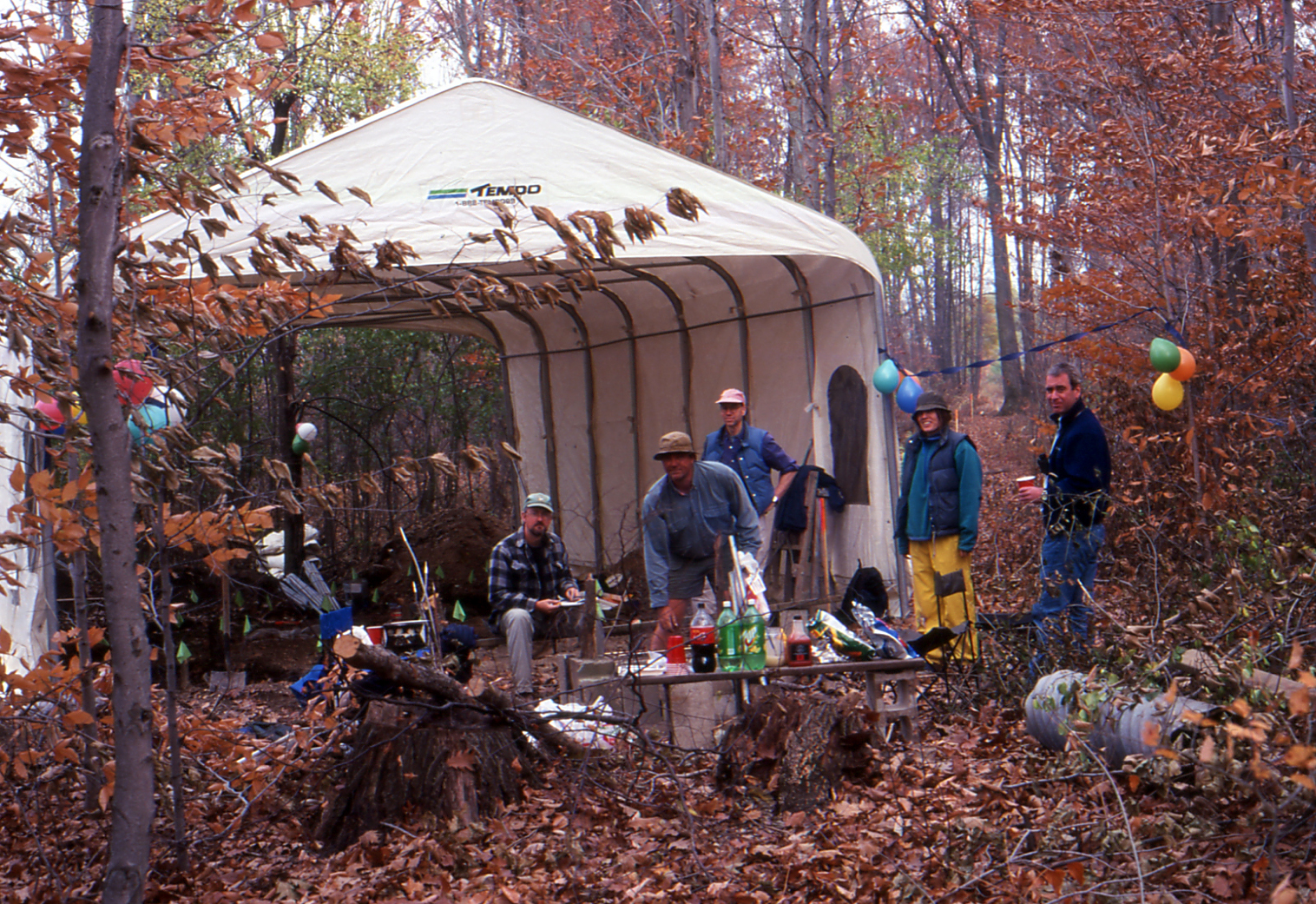Today vehicles drive right though the exact spot where more than 90 centuries ago a small band of hunters set up camp and went about their daily lives shaping stone into tools and weapons.
Welcome to the Huson Site, a site so rare in Ontario, ASI pulled out all the stops to decipher and understand the significance of this ancient camp that until recently sat in the shadow of a massive landfill.
In the autumn 2001, ASI staff conducting test pits in a small mature forest on the east side of Thorold, Ontario, discovered the rare site sitting half a kilometre off the edge of the Niagara Escarpment. What followed were weeks and months of fieldwork and lab work to fully understand what a small group of hunters were doing there so long ago.
It became apparent by the sheer number of stone waste material (also called debitage, created during the stone tool-making and resharpening process) that the Huson Site had not been severely disturbed, or even mildly disturbed, by historic forest clearing or farming practices, a very rare situation in Ontario for such an ancient site.
The Tent Goes Up and the Fieldwork Goes On

Under the protection of a large tent, ASI staff methodically worked to locate, map, and recover thousands and thousands of pieces of debitage left in place where they fell by the small group scratching out a living in a challenging post-glacial environment.
As the piece-plotting of each tiny stone flake proceeded, visits by experts and academics from multi-disciplines dropped by to poke, prod and probe the site and its findings. Geology, paleobotany, pedology, sedimentology, soil micromorphology and many archaeological techniques and procedures were brought to the fore, all with the same goal of helping to unravel what happened at the site before, during, and after prehistoric human occupation.
All of the recovered 9,407 stone artifacts were created from Onondaga chert, a grey-bluish flint-like rock that occurs naturally at the other end of the Niagara Peninsula along the Lake Erie shoreline where it is exposed along beaches and rock cuts. This easily-worked material was highly sought after by Ontario’s first peoples for millennia to create a variety of tools from scrapers and bifaces to projectile points and drills. It was so highly-favoured that it was traded all over northeastern North America.
Once all the fieldwork had been completed, 60 one-square-metre units had been excavated, 19 of which produced all recovered artifacts and were thus piece-plotted. Of the 9,407 artifacts recovered, 27 were worked stone tools comprised of 14 expedient/informal flake tools, six unifacial artifact fragments, four bifacially-worked tools, a drill and two end scrapers. Judging by the extent the artifacts were worked and the type of flakes produced in their creation or resharpening, it appeared that the occupants of the camp were busy breaking down and refining rough cores of chert and refining bifaces and resharpening existing tools.
How Old?
So how can we place a date on when the Huson Site was occupied? First, analysis of some of the finished tools tells us that the site was likely occupied during the Early Archaic Period (7,700 – 6,900 BC) of Ontario’s prehistory. The two end scrapers and a small stone “piercer” recovered are comparable to specimens common to that period found at other sites in Ontario from this time period. The stone drill is identical to such drills found at sites attributed to “Kirk corner-notched” assemblages such as the Nettling Site southwest of London, Ontario. Further, paleobotany specialists analyzing the pollen content from soil samples from two of the three cultural features (in this case concentrations of chert flakes) found that the majority of pollen was pine in origin and the vast majority of that pollen was jack pine. Jack pine was the dominant species of tree in Southern Ontario 6,000 to 8,000 BC.
The fact that the distribution of the stone waste flakes was confined to a tight limited area and that soil studies revealed that the naturally deposited soil layers had seen little disturbance over the many centuries, points to the Huson Site as being as close to pristine, undisturbed site as you will find in the 21st Century. It is incredible that such an ancient camp had never been ripped and scattered by historic pioneer tree clearances, ox, or horse-drawn ploughs or mechanical ploughs as is the case 9 times out of 10 in Ontario archaeology.
If you are ever in Thorold, Ontario driving down Taylor Road on your way to the Falls, the outlet malls or the casino, ponder for a moment a small group of hunters at their camp, sitting in a cool, pine forest, chipping away at stone to produce the tools and weapons vital for day-to-day survival in a very different Ontario.









